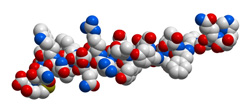Measuring peptide partitioning
In eukaryotes such as bacteria and humans, hydrophobic peptides are transported via the translocon machinery into lipid bilayers to form stable transmembrane (TM) helices. The mechanism of peptide transfer into the lipid bilayer in our organelles is unclear as accurate measurements are hampered by peptide aggregation in solution. The EU-funded 'Experimental measurement of the direct partitioning of peptides into lipid bilayers' (PEPTIDE PARTITIONING) project successfully performed quantitative estimates of the free-energy change that occurs when peptides from water are transferred into lipid bilayers. Through simulations, researchers folded single TM helices directly into membranes. Project outcomes should provide novel insights into the formation and structure of membrane proteins as well as their function using the experimentally validated simulation technique. This in silico approach could also be adapted to simulate protein-folding dynamics in complex multi-span membrane proteins. PEPTIDE PARTITIONING members designed synthetic water-soluble membrane-associated peptides to directly quantify free-energy changes using an experimental membrane insertion assay. These peptides were derived by modifying pH (low) insertion peptides (pHLIPs). Their solubility at neutral pH and ability to spontaneously insert into lipid bilayers when the pH is lowered enabled measurement of their partitioning free-energy. For in silico studies at the atomic level, extended polypeptides in water were allowed to fold freely as well as partition in and out of lipid bilayers. Measurements made of the thermal changes, energy states and equilibrium conditions were found to correlate with experimental results. Results were validated on a synchrotron radiation circular dichroism spectroscopy and the experimental membrane insertion assay. A greater understanding of TM protein dynamics will enable the design of novel membrane protein folds with major implications for the biomedical and pharmaceutical sectors. For instance, innovative treatments could be developed for cancer, neurological and psychiatric disorders.







